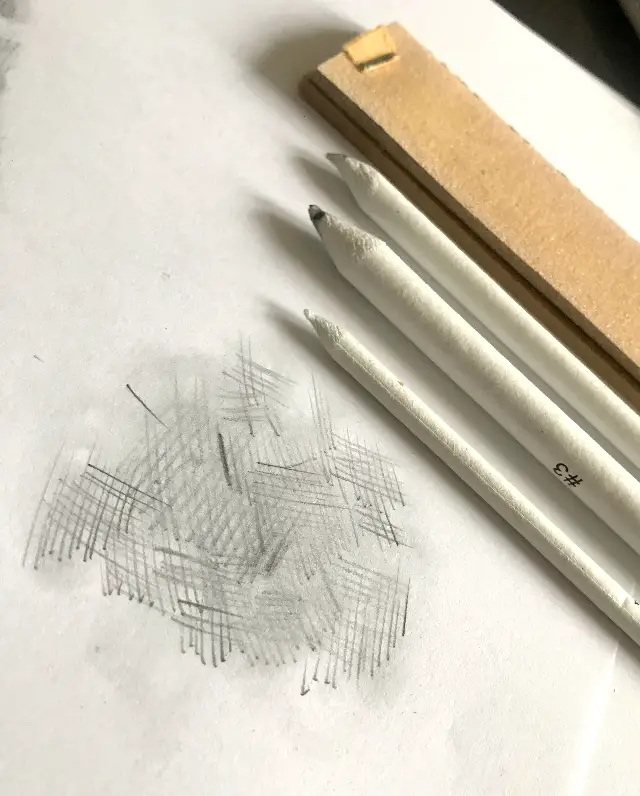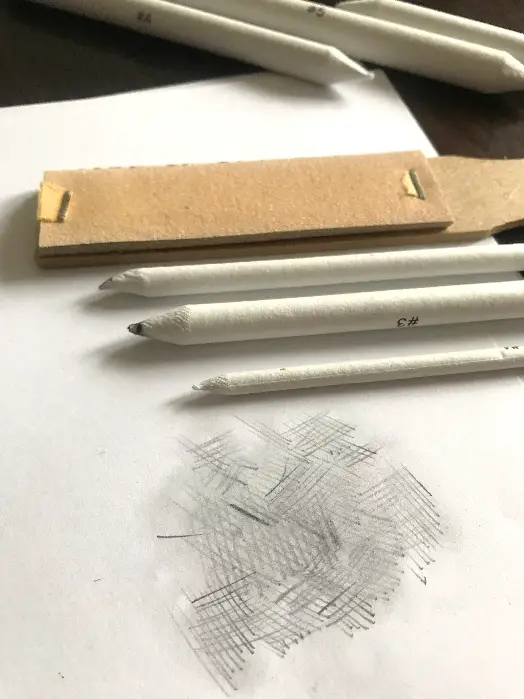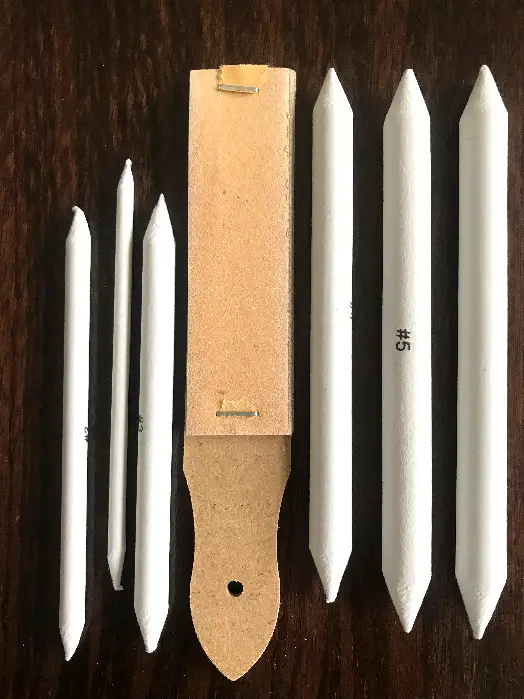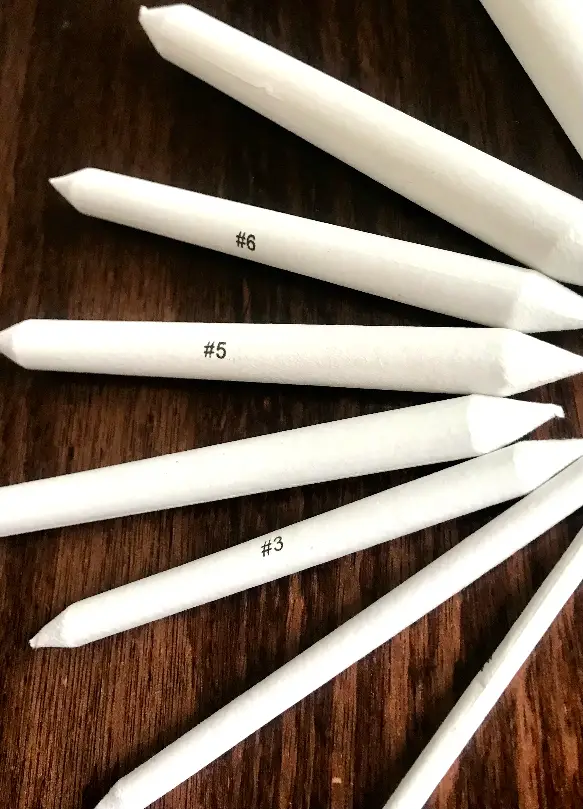Blending stumps and tortillons are a pair of similar tools that every artist that works in graphite, charcoal, pastel, or any other type of dry medium should familiarize themselves with.
Blending is a challenge every artist faces, so having tools that can help you more effectively and precisely blend when drawing should be something you are very interested in.
But wait, can't you just use your finger to blend with it? Or what about a kneaded eraser? These are both options, and both are good options in some circumstances. But blending stumps and tortillons are different tools that give you more precise control when blending.
Tortillon vs. Blending Stump: What Are They Used For?
Plus, they keep your fingers clean, which is always a plus. Dirty fingers leave smudgy marks on your drawing, which can ruin a lot of hard work.
Please look at this drawing and sketching video course I have created. Use this link.
Are Blending Stumps and Tortillons the Same?
Do blending stumps and tortillons look similar? Yes. Are they used for similar purposes? Yes. Are they two names for the same thing? No. While similar in look and function, they are each a different artist tool. Is one better than another?
That's like asking if graphite is better than charcoal. Or if oils are better than acrylics or watercolors. The point is that there is no better or worse; there is only a difference.
The other thing to remember is that both are inexpensive, so there's no reason to choose between them. You should have a sufficient supply of each on hand before you start drawing since it won't cost you much and will ensure you have the tools you need to execute a drawing on your terms.
What is the difference between a blending stump and tortillon? It all comes down to how they are made. Blending stumps are made from paper pulp and formed into a solid stump.
Tortillons are made from sheets of paper that are tightly wound to create a point that can be used for blending. Blending stumps are more expensive than tortillons, and they are softer and offer the ability to create more subtle blending areas.
On the other hand, tortillons are usually smaller, more challenging, and don't blend. Why would you want to use tortillons? They are cheap; you can buy a dozen for a few dollars.
They also work exceptionally well for most artists, and since they are so inexpensive, you can buy a bunch of different sizes, giving you more versatility.
Are Blending Stumps Necessary?
So if you ever hear from anyone that you need blending stumps, they're wrong. You don't need them if you don't want them.
Are they useful? Absolutely, but that hardly makes them a necessity. Blending stumps are an excellent tool for any artist that blends their drawings. What if you draw with ink? Or you don't want to blend your drawings?
Then you don't need blending stumps. But if you do any blending when you're drawing, and you aren't using blending stumps, then you are doing yourself a disservice.
What Are Tortillions Used For?
Some artists opt to use only tortillons because they are less expensive than blending stumps and look similar enough that it's easy to assume they are identical in use.
However, this is not the case. Blending stumps have a much softer, more velvety type of surface to them when compared with tortillons. This usually gives the artist more control when blending, allowing them to achieve softer, smoother transitions in value.
Despite their ability to achieve smoother transitions, blending stumps are usually much firmer. This gives an artist more control since the tip of the stump won't usually bend, unlike tortillons.
Some artists choose tortillons instead of blending stumps because of the cost. Blending stumps are far from expensive, but you can usually buy 10 or more tortillons for the exact cost of a single blending stump.
But, it's essential to remember that tortillons wear out quickly and have to be thrown out, whereas blending stumps can last very long. What do you do with a tortillon when it gets saturated with graphite or charcoal?
You can still use it in dark areas of a drawing, but that's pretty limiting, so most artists just throw them out. What do you do when a blending stump gets dirty? You can use a kneaded eraser to clean the surface, returning it to a usable condition.
What about when a blending stump becomes blunted, making fine control difficult? No problem, simply sharpen it with some sandpaper, and you're good to go.
Are Blending Stumps Good for Blending?
If you're wondering whether or not blending stumps are suitable for blending, the answer is simple, it's yes. That's why they're called blending stumps! Blending stumps have a soft, smooth texture that allows artists a great deal of fine control when blending from one value to the next.
Many artists grow up using their fingers to blend, but take a moment and look at your finger. Does it have a fine point on it? Probably not. It's round and thick, so it's hardly ideal for precision blending.
On the other hand, blending stumps have a fine point on them, allowing you to blend with the same type of precision that you draw with. When that point begins to dull, and it will, you can quickly restore it with sandpaper.
Why use blending stumps? It all comes down to control. If you're an artist who works using fine details and smooth transitions in value, then having a precision tool is necessary.
Tortillons are another option, but most artists, once they use a blending stump, will tell you that it's usually a superior option in most cases.
What Pressure Should be Applied when Using a Blending Stump?
If you're curious about how much pressure should be used when using a blending stump, the answer is that it depends. That's like asking how hard you should press on a pencil when drawing something.
It all depends on what you're trying to accomplish. Are you trying to do a little light blending? Then use a light amount of pressure. Are you trying to really get into the paper and blend darker values?
Then you're going to want to use a lot of pressure. The great thing about blending stumps is that they are durable enough to withstand a lot of pressure and versatile enough to handle a lighter touch.
What is a Blending Stump?
What is a blending stump? It's a tool, plain and simple. Will it magically make you a better artist? No. It will not do the work for you, but it will make doing it easier for you.
Think about it this way: when you are trying to create a drawing with a wide range of values and use graphite, you'd want to use various pencils, right? Of course, you would. You'd want to use harder pencils for lighter values and fine details.
Then you'd want to use softer pencils for darker values. It's all about having the right tool for the job at hand. That's what a blending stump is. It's the right tool for blending. Blending stumps are made in much the same way that paper is made since they are made of paper. They are made from paper pulp, shaped, hardened, and then sharpened.
What is a Tortillon?
At first glance, you might mistake a tortillon for a blending stump. If that happens, don't feel too bad about it, this is a common mistake. Tortillons strongly resemble blending stumps, and they're even used for the same purpose.
But, tortillons are meant to be a more disposable tool since they are so inexpensive. Why would you want to use tortillons instead of blending stumps? A lot of it comes down to convenience.
Tortillons are very inexpensive. You can buy a package with 10 assorted sizes for a few dollars. It's not a big deal when they become saturated with graphite, charcoal, or whatever else you are working with. Just throw it out and grab a new one.
When the tip begins to dull, can you sharpen it? No, but once again, just get another one. Tortillons are an inexpensive artist tool you should use to supplement blending stumps.
What Are Tortillions Made of?
Tortillons, like blending stumps, are made of paper. But that's where the similarities end. Blending stumps are made from paper pulp and are solid sticks of paper.
Tortillons are also made from paper, but they are made from tightly wound sheets of paper. They are made with a point, but that point tends to dull quickly with use.
What Do You Use Tortillons For?
Tortillons are an artist tool used for blending dry mediums. You can use tortillons to blend it, charcoal, graphite, colored pencils, or anything else.
Tortillons are often favored by artists who enjoy drawing and sketching on location. If you like to bring a sketchbook, tortillons are small enough to fit in your pocket, giving you access to a blending tool when you aren't at home or in your studio.
Tortillons can be used instead of blending stumps, but artists often use them as a supplement for their blending stumps.
What Do Tightly Rolled Tortillons Do?
Why are tortillons so tightly wound? Tortillons are made from paper. The paper is not very strong. Even if you invest in higher-quality paper, it's pretty clear that it's not the most durable material in the world.
When using tortillons, there will be times when you'll have to apply a good amount of pressure. If you applied that kind of pressure on a piece of paper, it would crumble or tear.
But, if you took that piece of paper and wound it tightly, you would discover that it was much harder and more durable. Tightly winding the paper in a tortillon creates a harder object that can handle the abuse you will subject it to.
How Do You Use Blending Stumps and Tortillons?
Don't make the mistake of thinking you must choose between blending stumps and tortillons. While quite similar, they are different enough to warrant having both of these tools on hand when working on a drawing.
Think of it this way, when you are working on a graphite or charcoal drawing, you have different types of these materials on hand, right? Or, what about colored pencil artists?
Could you imagine trying to work on a drawing without a full complement of colors? That's how you should treat blending stumps and tortillons.
Many artists will use blending stumps as a finishing tool and tortillons during the initial stages of a drawing. While blending stumps can be cleaned with a kneaded eraser and sharpened with sandpaper, there's no need to invest this time when working on a drawing.
Instead, you can use tortillons for larger areas, rough layouts, and initial shading. When one becomes dull or dirty, you just throw it out and grab a new one.
Blending Stumps and Tortillons Will Help You to Become a Better Artist
As an artist, you should always look for ways to grow and expand your skills. One of the simplest ways to do this is to invest in inexpensive art supplies that will be enormously helpful to you.
Combining graphite, charcoal, colored pencils, or any other dry medium can be very challenging. Learning how to do so takes time, practice, and the right tools.
If you're still using your finger for mixing, do yourself a favor, go to an art store and pick up some blending stumps and tortillons. It won't cost you much, and you'll probably be astonished at how much of a difference these simple little tools can make.
Create Art With My Favourite Drawing Resources
General Drawing Courses. I like Udemy if you want to develop your knowledge of drawing techniques. Udemy is an excellent choice due to its wide range of creative courses and excellent refund policy. They often have monthly discounts for new customers, which you can check here. Use my link.
Sketching and Collage. Take a look at this sketching resource I have created. Use this link.
Proko. Is one of my favorite teachers who surpasses in the teaching of Anatomy and Figure drawing. Prokos course breaks down the drawing of the human body into easy-to-follow components aiding the beginner to make rapid progress. For this, I really like Proko.
Art Easels. One of my favorite ways to draw is by using a drawing easel, which develops the skill of drawing on a vertical surface. The H frame easel is an excellent vertical way to add variety to the style and type of marks you create when using a drawing board.
To see all of my most up-to-date recommendations, check out this resource I made for you.




